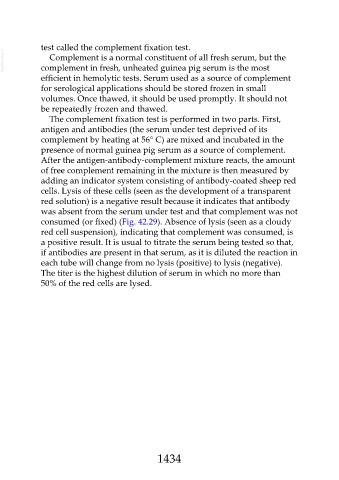Page 1434 - Veterinary Immunology, 10th Edition
P. 1434
test called the complement fixation test.
VetBooks.ir complement in fresh, unheated guinea pig serum is the most
Complement is a normal constituent of all fresh serum, but the
efficient in hemolytic tests. Serum used as a source of complement
for serological applications should be stored frozen in small
volumes. Once thawed, it should be used promptly. It should not
be repeatedly frozen and thawed.
The complement fixation test is performed in two parts. First,
antigen and antibodies (the serum under test deprived of its
complement by heating at 56° C) are mixed and incubated in the
presence of normal guinea pig serum as a source of complement.
After the antigen-antibody-complement mixture reacts, the amount
of free complement remaining in the mixture is then measured by
adding an indicator system consisting of antibody-coated sheep red
cells. Lysis of these cells (seen as the development of a transparent
red solution) is a negative result because it indicates that antibody
was absent from the serum under test and that complement was not
consumed (or fixed) (Fig. 42.29). Absence of lysis (seen as a cloudy
red cell suspension), indicating that complement was consumed, is
a positive result. It is usual to titrate the serum being tested so that,
if antibodies are present in that serum, as it is diluted the reaction in
each tube will change from no lysis (positive) to lysis (negative).
The titer is the highest dilution of serum in which no more than
50% of the red cells are lysed.
1434

